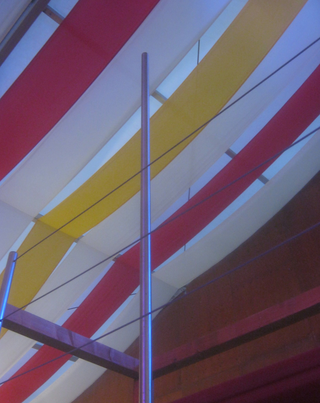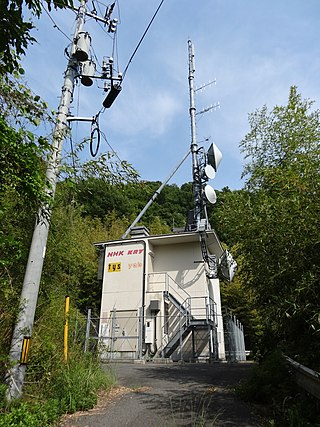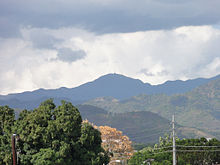
Low-power broadcasting is broadcasting by a broadcast station at a low transmitter power output to a smaller service area than "full power" stations within the same region. It is often distinguished from "micropower broadcasting" and broadcast translators. LPAM, LPFM and LPTV are in various levels of use across the world, varying widely based on the laws and their enforcement.

Georgia Public Broadcasting (GPB) is a state network of PBS member television stations and NPR member radio stations serving the U.S. state of Georgia. It is operated by the Georgia Public Telecommunications Commission, an agency of the Georgia state government which holds the licenses for most of the PBS and NPR member stations licensed in the state. The broadcast signals of the nine television stations and 19 radio stations cover almost all of the state, as well as parts of Alabama, Florida, North Carolina, South Carolina and Tennessee.

WWNY-TV is a television station licensed to Carthage, New York, United States, serving as the CBS affiliate for the Watertown area. It is owned by Gray Television alongside low-power, Class A Fox affiliate WNYF-CD. The two stations share studios on Arcade Street in downtown Watertown; WWNY-TV and WNYF-CD's transmitters are located on the same tower along NY 126/State Street on Champion Hill.
KHET, branded as PBS Hawai'i, is a PBS member television station in Honolulu, Hawaii, United States, serving the Hawaiian Islands. Owned by the Hawaii Public Television Foundation, the station maintains studios on Sand Island Access Road in Honolulu, and its main transmitter is located on Palehua Ridge, north of Makakilo.

WGTV is a PBS member television station licensed to Athens, Georgia, United States, a legacy of the station's early years as a service of the University of Georgia (UGA). Owned by the Georgia Public Telecommunications Commission, it is the flagship station of the statewide Georgia Public Broadcasting (GPB) television network, serving the Atlanta metropolitan area from a transmitter atop Stone Mountain just east of Atlanta.

HD Radio (HDR) is a trademark for an in-band on-channel (IBOC) digital radio broadcast technology. HD radio generally simulcasts an existing analog radio station in digital format with less noise and with additional text information. HD Radio is used primarily by AM and FM radio stations in the United States, U.S. Virgin Islands, Canada, Mexico and the Philippines, with a few implementations outside North America.

WRGB is a television station licensed to Schenectady, New York, United States, serving the Capital District as an affiliate of CBS. It is owned by Sinclair Broadcast Group alongside CW affiliate WCWN. The two stations share studios on Balltown Road in Niskayuna, New York ; WRGB's transmitter is located on the Helderberg Escarpment west of New Salem.
A television transmitter is a transmitter that is used for terrestrial (over-the-air) television broadcasting. It is an electronic device that radiates radio waves that carry a video signal representing moving images, along with a synchronized audio channel, which is received by television receivers belonging to a public audience, which display the image on a screen. A television transmitter, together with the broadcast studio which originates the content, is called a television station. Television transmitters must be licensed by governments, and are restricted to a certain frequency channel and power level. They transmit on frequency channels in the VHF and UHF bands. Since radio waves of these frequencies travel by line of sight, they are limited by the horizon to reception distances of 40–60 miles depending on the height of transmitter station.
Arkansas PBS is a state network of PBS member television stations serving the U.S. state of Arkansas. It is operated by the Arkansas Educational Television Commission, a statutory non-cabinet agency of the Arkansas government operated through the Arkansas Department of Elementary and Secondary Education, which holds the licenses for all of the public television stations based in the state. The commission is managed by an independent board of university and education officials, and gubernatorial appointees representing each of Arkansas's four congressional districts. Along with offering television programs supplied by PBS and various independent distributors, the network produces public affairs, cultural and documentary programming as well as sports events sanctioned by the Arkansas Activities Association (AAA).
This glossary of terms used in broadcasting is a list of definitions of terms and concepts related to both radio and television broadcasting, along with the industry in general.

KAUU is a television station in Anchorage, Alaska, United States, affiliated with MyNetworkTV. It is owned by Gray Television alongside dual NBC/CBS affiliate KTUU-TV. The two stations share studios on East 40th Avenue in Anchorage; KAUU's transmitter is located in Knik, Alaska.

KTVE is a television station licensed to El Dorado, Arkansas, United States, serving as the NBC affiliate for the Monroe, Louisiana–El Dorado, Arkansas market. It is owned by Mission Broadcasting, which maintains a local marketing agreement (LMA) with Nexstar Media Group, owner of West Monroe, Louisiana–licensed Fox affiliate KARD, for the provision of certain services. The two stations share studios on Pavilion Road in West Monroe; KTVE's transmitter is located northwest of Huttig, Arkansas.
The class A television service is a system for regulating some low-power television (LPTV) stations in the United States. Class A stations are denoted by the broadcast callsign suffix "-CA" (analog) or "-CD" (digital), although very many analog -CA stations have a digital companion channel that was assigned the -LD suffix used by regular (non-class-A) digital LPTV stations.

KMOH-TV is a television station in Kingman, Arizona, United States, airing programming from MeTV. Owned and operated by Weigel Broadcasting, the station has studios on Kingman Avenue in Kingman, and its transmitter is located atop Oatman Mountain, near Oatman, Arizona.
DZOZ-DTV is a digital-only television station in Metro Manila, Philippines, serving as the flagship of the Light TV network. It is owned and operated by ZOE Broadcasting Network alongside A2Z flagship DZOE-TV, which is operated by ABS-CBN Corporation under a blocktime agreement. Both stations share studios at the 22nd floor, Strata 2000 Bldg., Emerald Avenue, Ortigas Center, Pasig, while DZOZ-DTV's transmitter is located at Crestview Heights Subdivision, Barangay San Roque, Antipolo, Rizal.

A broadcast relay station, also known as a satellite station, relay transmitter, broadcast translator (U.S.), re-broadcaster (Canada), repeater or complementary station (Mexico), is a broadcast transmitter which repeats the signal of a radio or television station to an area not covered by the originating station.
The digital transition in the United States was the switchover from analog to exclusively digital broadcasting of terrestrial television programming. According to David Rehr, then president and CEO of the National Association of Broadcasters, this transition represented "the most significant advancement of television technology since color TV was introduced." For full-power TV stations, the transition went into effect on June 12, 2009, with stations ending regular programming on their analog signals no later than 11:59 p.m. local time that day.

UHF television broadcasting is the use of ultra high frequency (UHF) radio for over-the-air transmission of television signals. UHF frequencies are used for both analog and digital television broadcasts. UHF channels are typically given higher channel numbers, like the US arrangement with VHF channels (initially) 1 to 13, and UHF channels (initially) numbered 14 to 83. Compared with an equivalent VHF television transmitter, to cover the same geographic area with a UHF transmitter requires a higher effective radiated power, implying a more powerful transmitter or a more complex antenna. However, the additional channels allow more broadcasters in a given region without causing objectionable mutual interference.
KGHD-LD is a low-power television station in Las Vegas, Nevada, United States. The station is owned by Obidia Porras.










